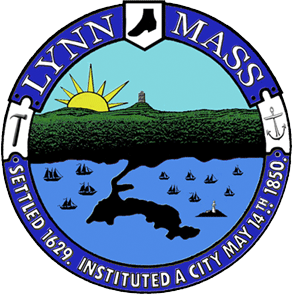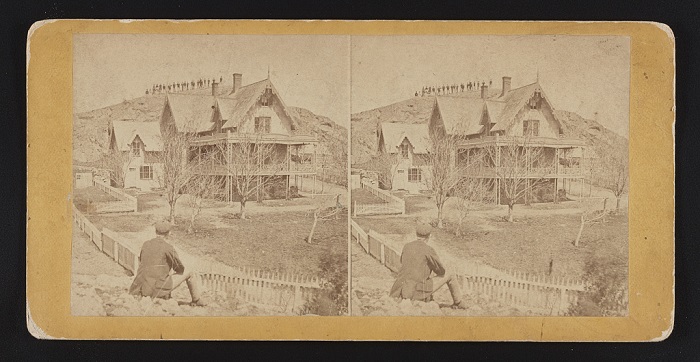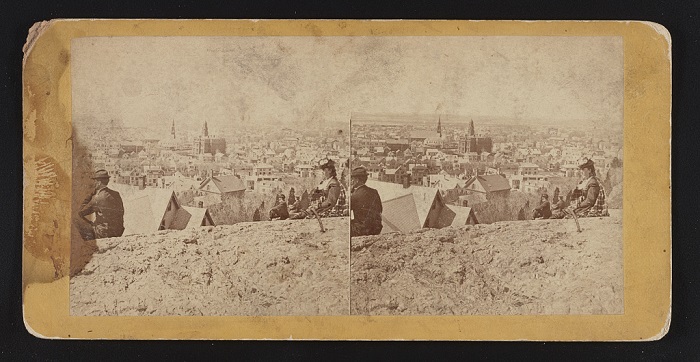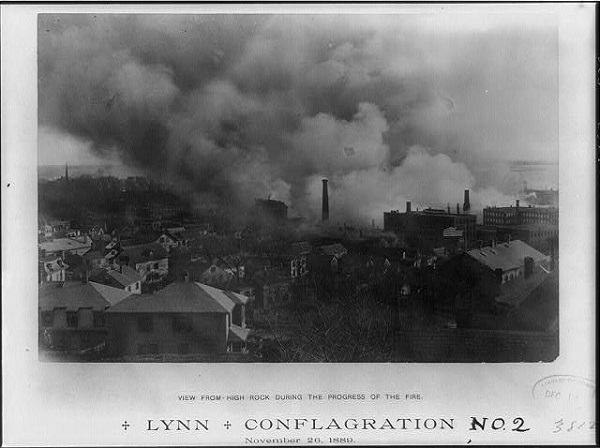Originally known as Saugus, Lynn is one of the oldest towns in Massachusetts. First settled in 1629, the town was incorporated into the Massachusetts Bay Colony only a few years later.
The following is a history of Lynn, Massachusetts:
1629:
- Saugus is settled by Salem colonist Edmund Ingalls and four others.
1631:
- Saugus is incorporated as a town into the Massachusetts Bay Colony in 1631.
1637:
- Saugus is renamed Lynn after Lynn Regis, England.
1638:
- The first land division between the colonists takes place.
1639:
- A ferry service is established on the Saugus River.
1658:
- Needham’s Landing, a local ferry, is established by Garrett Spenser on the Saugus River.
- A pirate, named Thomas Veale, hiding out in a cave in Dungeon Rock is reportedly killed when an earthquake strikes the area and the cave collapses on him and buries him with his treasure.
1686:
- On September 4, Selectmen from Lynn, Ralph King, William Bassett Sr, Matthew Farrington Sr, John Burrill Sr, Robert Potter Sr, Samuel Johnson, and Oliver Purchas, sign a land deed with the local Naumkeag tribe for the land in Lynn, Reading, Lynnfield, Nahant and Swampscott.
1699:
- Colonist Boniface Burton dies reportedly at 113 years of age.
1706:
- Lynn Common is established as a training field for the local militia.
- A second land division between the colonists takes place.
1720:
- The Lynn Woods wolf pits are established in the Lynn Woods to trap wolves.
1722:
- The New Light Cemetery is established on Silsbee Street.
1737:
- The Western Burial Ground is established in Market Square.
1757:
- The John Hawkes House is built on Boston Street.
1784:
- The James Ingalls House is built on Lafayette Park.
1790:
- The population of Lynn is 2.291.
1791:
- The Daniel Newhall House is built on Barrett Street.
1793:
- The Lynn Post Office is built on Boston Street.
1794:
- The Samuel Ramsdell – Timothy Newhall House is built on Essex Street.
1795:
- On December 9, the Brig Peggy wrecks on Long Beach and nine crew members die.
1798:
- The Moses Chadwell House is built on South Street.
1800:
- The population of Lynn is 2,837.
1803:
- The Lynn Hotel is built.
1804:
- On July 4, Independence Day is first celebrated in Lynn.
1810:
- The population of Lynn 4,087.
1813:
- The Eastern Burial Ground is established on Union Street.
1814:
- The Usher – Mechanics Bank Block is built on City Hall Square.
1815:
- A section of Lynn splits off and becomes modern day Saugus.
- The Micajah Pratt Shoe Factory is built on Broad Street.
1819:
- A sea serpent is reportedly spotted near Long Beach.
- Nahant Hotel is built.
- An Almshouse is built on Tower Hill.
1820:
- The population of Lynn is 4,515.
- The E. Estes Shoe Factory – Archibald Martin House is built on Broad Street.
- The Fox Rock Road is constructed in the Lynn Woods.
1824:
- On August 31, General Marquis de Lafayette visits Lynn during his tour of the United States.
1825:
- The Daniel Newhall House and Shop is built on Nahant Street.
- On September 3, the first newspaper in Lynn, the Weekly Mirror, is published.
1830:
- The population of Lynn is 6,138.
1835:
- The Blaney Chase Mechanics Store is built on Broad Street.
1836:
- The Nathan Dow Chase Shoe Factory is built on Broad Street.
1840:
- The population of Lynn is 9,367.
1841:
- Frederick Douglass moves to Lynn.
- On September 28, Frederick Douglass is thrown off the Eastern Railroad at Lynn Central Square Station for refusing to sit in the segregated coach.
1843:
- On March 17, a schooner called the Thomas wrecks on Long Beach and five crew members die.
1847:
- High Rock Cottage, a Gothic Revival-style stone cottage with a tower, is built on Johns Ave.
- Exchange Hall, a three-story Italiante-style building with commercial space on the bottom floor and a meeting hall on the upper floors, is built on Market Street.
- On July 5, President James K. Polk visits Lynn.
1848:
- Carriage Road is built.
1849:
- The Robinson Shoe Factory, a Greek Revival-style building, is built on South Common Street.
- The Lynn Police Court is established.
1850:
- The population of Lynn is 14,257.
- Lynn is reincorporated as a city.
- The Pine Grove Cemetery is established on Boston Street and is consecration on July 24.
- The Old Lynn High School, a late Victorian-style building, is built on High Street.
- On August 15, a picnic is held at Lynnfield Pond and 13 picnickers drown in the pond.
- The Frog Rock Trail and the Under Cliff Path are constructed in the Lynn Woods.
1851:
- A spiritualist named Hiram Marble purchases the land where Dungeon Rock is located and begins excavating the collapsed cave, claiming he is receiving instructions from Veale’s ghost to help him find his buried treasure.
1852:
- Hiram Marble opens Dungeon Rock as a tourist attraction, called Pirate’s Glen, to raise funds for the excavation.
1853:
- The Boston Street Methodist Episcopal Church is built on Boston Street.
1859:
- On May 28, a fire breaks out at St. Mary’s Church
1860:
- The Warren Five Cents Savings Bank House is built on South Common Street.
- The population of Lynn is 19,083.
1864:
- On December 10, a schooner called the Lion wrecks on Long Beach and all six crew members die.
1865:
- The G. Draper Alonso Marker is established at the Pine Grove Cemetery on Boston Street.
- On April 3, news of the fall of Richmond reaches Lynn and town celebrates by ringing church bells.
1866:
- The Lynn Civil War Memorial is established at the Pine Grove Cemetery on Boston Street.
- The Samuel Flanders Shoeshop is built on Union Court.
1867:
- The Lynn First Baptist Church is built on North Common Street.
1868:
- The Pine Grove Cemetery Keeper’s House is built on Boston Street.
- The Nichols and Ingalls Shoe Factory is built on Monroe Street.
1869:
- A major fire breaks out and destroys much of central Lynn.
- The Harrison Newhall Shoe Factory is built on Monroe Street.
- The Edwin Johnson Shoe Factory is built on Monroe Street.
1870:
- The Lynn Central Market and Music Hall is built on Central Ave.
- The Johnson – Tyler – Foster Shoe Factory is built on Munroe Street.
- The James Grover – Sanborn, Benjamin Shoe Factory is built on Munroe Street.
- The Pratt and Boyce Shoe Factory is built on Broad Street.
- The Dungeon Rock tunnel is constructed on Waycross Road.
- The population of Lynn is 28,233.
1871:
- The Civil War Soldiers’ Monument is built on North Common Street.
- The Mary Baker Eddy House, an Italiante-style house later owned by Christian Science founder Mary Baker Eddy, is built on Broad Street.
- The George Spinney – Daniel A. Caldwell Shoe Factory is built on Oxford Street.
- The Lynn First Congregational Church is built on South Common Street.
- The Walnut Street Pumping Station is built on Walnut Street.
- The Lynn Fifth Methodist Church is built on Maple Street.
- The Edson – Tucker – Brown Shoe Factory is built on Munroe Street.
1872:
- The John H. Crossman Carpentry Shop is built on Buffum Street.
- The Washington Street Baptist Church is built on Washington Street.
- The Estes Store is built on Union Street.
1876:
- The Central Building (Sweetser Factory Building) is built on Central Ave.
1877:
- The Pinkham Warehouse – Jennie Pinkham House is built on Western Ave.
1879:
- The Thomas Page Richardson Shoe Factory is built on Central Ave.
- The Sherry Block – Patrick P. Sherry Shoe Factory is built on Munroe Street.
1880:
- The Augustus B. Martin Monument is established on Boston Street.
- The Ann Maria Coffin Marker is established at the Pine Grove Cemetery on Boston Street.
- The Lynn Masonic Hall is built on Liberty Street.
- The Saint Mary’s Church Parochial School is built on Pleasant Street.
- The Charles B. Tebbetts Shoe Factory is built on Willow Street.
- The Boyden Hotel is built on Union Street.
- The Warren Toppan Apothecary – Toppan Building is built on Baldwin Street.
- Saint Joseph’s Roman Catholic Church is built on Union Street.
- The population of Lynn is 38,274.
1881:
- The Saint Stephen’s Memorial Church is built on South Common Street.
1882:
- The Charles H. Aborn Shoe Factory is built on Broad Street.
- The M. C. Heald Bottling Works is built on Commercial Street.
1883:
- The Lydia Pinkham Estes Marker is established at the Pine Grove Cemetery on Boston Street.
1884:
- Birch Pond Dam is constructed in the Lynn Woods.
1885:
- The G.A.R. Hall and Museum is built on Andrew Street.
- The Church of the Incarnation is built on Broad Street.
- The Kaese House is built on Ocean Street.
- D.A. Caldwell and Company Shoe Factory is built on Oxford Street.
1886:
- The Lydia Pinkham Medicine Company building is constructed on Western Avenue.
1887:
- The Goodwin Brothers Shoe Factory is built on Almont Street.
- The Thomas F. Gaffney Carpentry Shop is built on Central Avenue.
- The M. O’Brien Commercial Block is built on Ocean Street.
1889:
- On November 26, the Great Lynn Fire of 1889 breaks out, destroying about 334 buildings.
- The Jan E. Matzeliger Monument is established on Boston Street.
- The Rhodes Memorial Chapel is established at the Pine Grove Cemetery on Boston Street.
- The Lynn Police Department Stable is built on Sutton Street.
1890:
- The S. F. Stearns Factory is built on Almont Street.
- The West Lynn Odd Fellows Hall is built on North Common Street.
- The V. K. Jones and H. A. Factory is built on Broad Street.
- The Stephen N. Breed Factory is built on Broad Street.
- The James Williams Manufacturing Building is built on Broad Street.
- The James W. Goldthwaite Livery Stable is built on Farrar Street.
- The E. H. Ashcroft Factory is built on Union Street.
- The J. L. Libbey and Sons Factory is built on Union Street.
- The Joseph G. Brown Shoe Factory is built on Union Street.
- The Charles Buffum and Daniel C. Shoe Factory is built on Union Street.
- The Lynn Woods Reservation, a 2,200 acre public reservation, is established.
- The population of Lynn is 55,727.
1891:
- The Moore Slipper Factory is built on Boston Street.
- The Oxford Club is built on Broad Street.
1892:
- The Burrill Elementary School is built on Boston Street.
- The Central Congregational Church is built on Broad Street.
- The English High School is built on Essex Street.
- The Aaron F. Smith Shoe Factory is built on Essex Street.
- The S. N. Breed Company Building is built on Washington Street.
- The Advent Christian Church is built on Liberty Street.
1893:
- The Colonel Tufts Gardner Monument is established on Boston Street.
- The Knights Templar Monument is established at the Pine Grove Cemetery on Boston Street.
- The Lynn Common Fountain is built on South Common Street.
- The Saint Mary’s Roman Catholic Church Rectory is built on South Common Street.
- The Lynn Armory is built on South Common Street.
1894:
- The Pinkham Carriage House is built on Baltimore Street.
1895:
- The Lynn Central Railroad Station is built on Central Square.
- The East Lynn Oddfellow’s Hall is built on Essex Street.
- The Lynn First Presbyterian Church is built on Franklin Street.
- The Rolfe Besse and Company Clothing Store is built on Market Square.
- The Lynn Common Bandstand is built on Lynn Common.
- The New England Telephone and Telegraph Company building is constructed on Oxford Street.
1896:
- The Lynn Gas and Electric Block is constructed on Exchange Street.
- The Saint Patrick’s Roman Catholic Church is built on Light Street.
1897:
- The Aborn Elementary School is built on Eastern Avenue.
- The Old Post Office Building is built on Willow Street.
1898:
- The Lewis Elementary School is built on Chestnut Street.
- The Saint Joseph’s Parochial School is built on Green Street.
- The Lynn Public Library is built on North Common Street.
1899:
- The Lynn First Pentecostal Church is built on Chestnut Street.
- The Hotel Osmund is built on Liberty Street.
- On June 28, astronomer Maria Mitchell dies at her sister’s home in Lynn at the age of 70.
1900:
- The Pan American Fruit Company building is built on Green Street.
- The population of Lynn is 68,513.
1901:
- Lynn Business College is built on Exchange Street.
1902:
- Penny Bridge is built in the Lynn Woods.
1904:
- The Saugus River Yacht Club is established on the Saugus River.
- The Revolutionary War Monument is built on North Common Street.
- The Welch Hill and Company Furniture Factory is built on Oxford Street.
- The High Rock Tower is built on Johns Ave.
- Lynn Shore Drive is constructed.
1905:
- The Oscar W. Buzzell Monument at the Pine Grove Cemetery on Boston Street.
- Walden Pond Dam is built in the Lynn Woods.
1906:
- The Saint Michael’s Roman Catholic Church is constructed on Summer Street.
- High Rock Reservation is established on Lawton Ave.
1907:
- The Little River Playground is built on Boston Street.
- Atlantic Terrace Stairway is built on Lynn Shore Drive.
1908:
- The Theatre Comique – DuPont Paint Store is built on Munroe Street.
1909:
- The Requiescant In Pace Memorial is established on Lynnfield Street.
- The Angell Fountain is built on Washington Square.
- The Lynn Second Congregational Church is built on Baltimore Street.
- The Goddard Brothers Department Store is built on Market Street.
1910:
- The Chatham Street Elementary School is built on Chatham Street.
- The Batchelder Garage is built on Nahant Street.
- Saint Michael’s Roman Catholic Church Convent and Rectory are built on Summer Street.
- The Blossom Street Railroad Bridge is built on Blossom Street.
- The Commercial Street Railroad Bridge is built on Commercial Street.
- The Breeds Pond Dam is built in the Lynn Woods.
- The Pleasant Street Railroad Bridge is built on Pleasant Street.
- The population of Lynn is 89,336.
1911:
- The Brickett Elementary School is built on Lewis Street.
- The Osmund Hotel Annex is built on Liberty Street.
- The Classical High School is built on North Common Street.
- The George H. Davis and William H. Factory is built on Willow Street.
- The Saugus River Drawbridge is built on the Saugus River.
- The Shepard Street Railroad Bridge is built on Shepard Street.
1912:
- The Bennett Street Railroad Bridge is built on Bennett Street.
- The Western Avenue – Salem Turnpike Bridge is built on Western Ave.
1913:
- The Lincoln Elementary School is built on Gardner Street.
- Chatham Street Railroad Bridge is built on Chatham Street.
- The Chestnut Street Bridge is built over the B&M Railroad line on Chestnut Street.
- The Eastern Railroad Bridge is built on Eastern Ave.
- The Fayette Street Bridge is built over the B&M Railroad line on Fayette Street.
- The Green Street Bridge is built over the B&M Railroad line on Green Street.
- The Silsbee Street Railroad Bridge is built on Shepard Street.
- The Market Street Railroad Bridge is built on Market Street.
- The Washington Street Railroad Bridge is built on Washington Street.
- The Eastern Railroad Station Viaduct is built on Mount Vernon Street.
- The Lynn Railroad Viaduct is built on Union Street.
1914:
- The Rev. John C. Harrington Memorial is established on Broadway.
- The Lewandos Cleaners building is constructed on Munroe Street.
1915:
- The Washington Community Elementary School is built on Blossom Street.
- The Atlantic Auto Company building is constructed on Central Ave.
- The Kensington Hotel is built on North Common Street.
- The Breeds Pond Bridge is built.
1917:
- The Saint Mary’s Roman Catholic Convent is built on City Hall Square.
- The Cobbett Primary School is built on North Commons Street.
- The Lynn Woods Elementary School is built on Trevett Avenue.
- The Pine Hill Fire Station is built on Woodlawn Street.
1918:
- The World War I Memorial is established at the Pine Grove Cemetery on Boston Street.
- The Lynn Firemen’s Memorial is established at the Pine Grove Cemetery on Boston Street.
1919:
- The Saint Joseph’s Parish House is built on Green Street.
- The Breakers is built on Lynn Shore Drive.
- The William T. Grant Department Store is built on Market Street.
- The Union Motors Showroom is built on Sutton Street.
1920:
- The Lynn World War I Monument – Honor Roll is established on Franklin Street.
- The Lynn Spanish American War Monument is established on Lynnway.
- The Sewell – Anderson Elementary School is built on Ontario Street.
- The Lynn Public School Administration Building is constructed on North Common Street.
- The population of Lynn is 99,148.
1921:
- The O’Keefe Elementary School is built on Franklin Street.
- The Buchanan Bridge is built on Western Ave.
1923:
- The Spanish-American War Monument is established at the Pine Grove Cemetery on Boston Street.
- The Corrado Memorial is established on Broadway.
- The Saint Michael’s Roman Catholic Parochial School is built on Summer Street.
1924:
- The Pickering Elementary School is built on Conomo Ave.
1925:
- The Boys’ Club – Vallodolid Association Building in North Common Street.
1926:
- The Highland Elementary School is built on Hollingsworth Street.
1927:
- The Boston Street Bridge is built on Boston Street.
- The Congregation Beth-El Synagogue is build on Breed Street.
1928:
- The McDermott Memorial is established on Broadway.
- The Sanders Drug Store is built on Atlantic Street.
- The Essex Tire Company building is constructed on Central Avenue.
- Ruth’s Hat Shop building is constructed on Munroe Street.
- The Capital Diner is built on Union Street.
- The Tracy Elementary School is built on Walnut Street.
1929:
- The Nathaniel L. Berry Marker is established at the Pine Grove Cemetery on Boston Street.
1930:
- The Keefe Memorial is established on Broadway.
- The Massachusetts Tercentary Sign is erected on Washington Square.
- The Massachusetts Highway Post is erected on Washington Square.
- The Equitable Co-Operative Bank is built on Oxford Street.
- The Lynn Police Headquarters is built on Sutton Street.
- The population of Lynn is 102,320.
1931:
- Hotel Edison is built on Bank Square.
- The New England Telephone and Telegraph Building is built on City Hall Square.
1932:
- The English High School is built on Goodridge Street.
1933:
- The U. S. Post Office – Lynn Main Branch is built on Willow Street.
1934:
- The Erwin Engler Garage – Laboratory is built on Deer Cove Street.
- The General Clarence R. Edwards Memorial Bridge is built on North Shore Road.
1936:
- The Burrill Stone Tower is built in the Lynn Woods.
- The Manning Bowl Football Stadium is built on Western Ave.
1937:
- The Elihu Thompson Marker is established at the Pine Grove Cemetery on Boston Street.
1938:
- The Century Tire Company building is built on Central Ave.
- The Harrington Elementary School is built on Dexter Street.
1939:
- The Bursaw Oil Company Gas Station is built on Willow Street.
1940:
- The Charles H. Woodbury Marker is established at the Pine Grove Cemetery on Boston Street.
- The Empire Store is built on Union Street.
- The Lynn Woods Ampitheater is built in the Lynn Woods.
- The population of Lynn is 98,123.
1941:
- The Boston Street Diner is built on Boston Street.
1942:
- The Abruzzese Memorial is established on Broadway.
1945:
- The Hill Texaco Station is built on Ocean Street.
1946:
- Saint Mary’s Roman Catholic Church is built on South Common Street.
1948:
- The Lynn Memorial City Hall and Auditorium is built on City Hall Square.
1949:
- Jerry’s Clothing Store is built on Munroe Street.
- The Lynn National Guard Armory Motor Vehicle Storage is built on Pleasant Street.
- The Temple Beth-El Synagogue School is built on Breed Street.
1950:
- The Don John Aliferis Monument is built on the Lynnway.
- The McDonough Square World War II Monument is built on Western Ave.
- The population of Lynn is 99,738.
1955:
- The Aristotle Agganis Marker is established on Boston Street.
1957:
- The Christian Science Church is built on Lynn Shore Drive.
1960:
- The Ahabt Shalom Synagogue is built on Ocean Street.
- The population of Lynn is 94,478.
1962:
- The New Angle Auto Glass Company Neon Sign is built on the Lynnway.
1964:
- The Lynn Police Monument is established at the Pine Grove Cemetery on Boston Street.
1965:
- The Lynn American Legion Post is built on North Common Street.
1969:
- The Shore View Nursing Home is built on Atlantic Terrace.
1970:
- The Salvation Army Store is built on Monroe Street.
- The population of Lynn is 90,294.
1977:
- The upper floors of Exchange Hall are removed, leaving only the commercial space on the street level intact.
1980:
- The Lynn Vietnam War Monument is built on North Common Street.
- The population of Lynn is 78,471.
1981:
- On November 28, a fire breaks out at the old Oxford Shoe Company factory in downtown Lynn, destroying 17 buildings and heavily damaging nine others.
1984:
- The MetroMed Building is constructed on Munroe Street.
1985:
- The Munroe Street Park is built on Munroe Street.
1987:
- The Lynn Works Sculpture is established on Broad Street.
- The Taylor Caldwell Bust is constructed on Michigan Ave.
1988:
- The Lynn War Memorial is established at the Pine Grove Cemetery on Boston Street.
1990:
- The Winnepurkit Tribe Monument is established at the Pine Grove Cemetery on Boston Street.
- The population of Lynn is 81,245.
1995:
- The Frederick Douglass Monument is built on South Common Street.
1997:
- The Lynn Women Veterans Memorial is established on Franklin Street.
2000:
- The population of Lynn is 89,050.
Sources:
History of Lynn, Essex County, Massachusetts: Including Lynnfield, Saugus, Swampscott, and Nahant. Vol. II, 1864-1893. The Nichols Press, 1897.
MACRIS, Massachusetts Cultural Resource Information System, Massachusetts Historical Commission, mhc-macris.net/
“A Brief History of Lynn.” City of Lynn, lynnma.gov/about/history.shtml
Liscio, David. “The Second Great Lynn Fire: 15 Years Later.” Firehouse, 31 Oct. 1996, firehouse.com/home/news/10545565/the-second-great-lynn-fire-15-years-later
“The Legend of Dungeon Rock and the Pirate Treasure It Holds.” New England Historical Society, newenglandhistoricalsociety.com/legend-dungeon-rock-pirate-treasure/
“Lynn Reconnaissance Report.” Massachusetts Department of Conservation and Recreation, May 2005, mass.gov/doc/lynn/download





My ancestor Garrett/Gerrard/Gaurard Spencer (Spenser) operated the Saugus River ferry although sone sources list him operating a ferry in Lynn as early as 1647. He moved to Haddam CT with wife Hannah son John Spencer and daughter Elizabeth Spencer Stannard and their families in the early 1660s